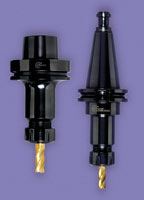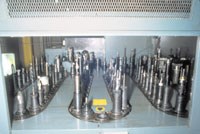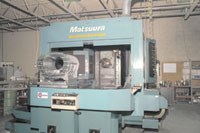Toolholder Selection Makes A Difference For Large Part Machining Operations
Machining very large cast iron parts often requires large amounts of material removal using wide cuts and deep bores, so the speeds seldom exceed 5,000 rpm.
Share


Hwacheon Machinery America, Inc.
Featured Content
View More
Autodesk, Inc.
Featured Content
View More





Machining very large cast iron parts often requires large amounts of material removal using wide cuts and deep bores, so the speeds seldom exceed 5,000 rpm. The need in this setup is not faster speeds, but a tough spindle that stays rigid while it attacks wide areas of hard metal.
Bechert Brothers Manufacturing of Forestville, Connecticut, is a 35-person, three-shift machining operation founded in 1977 by Jim Bechert, father of James and Bill Bechert who now handle day-to-day operations. Bechert Brothers specializes in machining these high precision cast iron and steel parts. Examples are rotary screw compressor housings of cast iron for HVAC systems that weigh 200 to 1,000 pounds, steel components used in couplings for helicopter rotors and bearing housings for gas turbine engines made from investment castings of 4140 carbon alloy steel.
These are difficult parts to machine accurately and cost effectively. Getting the accuracy needed on complex parts while maintaining productive feeds and speeds takes good planning as well as the right equipment, according to James Bechert, president. Also important are quality and precision, along with the avoidance of costly downtime. Bechert Brothers decided that a way to meet all these goals was to standardize its equipment. All of the company's machines are Matsuuras, and virtually all of its toolholders are from Command Tooling (Ramsey, Minnesota), according to Mr. Bechert. "The standardization makes a big difference in our consistency and repeatability. Our operators intimately know these machines, their software and the toolholder capabilities without having to deal with the vagaries of three or four different machine brands and models. The same is true with the toolholders.
"When our operators set up for one of these jobs, which involve hogging out large cavities and producing dozens of bores and tapped holes, they have the confidence of knowing, for example, that they can successfully get a ½-inch diameter cut in cast iron at 1,000 rpm without tool chatter. Because machines and toolholders have similar features, little things like setting coolant lines at the same height are easy because all the toolholders are the same length, being they are from the same manufacturer," says Mr. Bechert.
"For the same reason, the toolholders tighten up consistently so the operator doesn't have to guess what's right to get good concentric gripping force on the cutting tool—something that can cause a machine shutdown in the middle of a part run if it's not right."
To machine the compressor housings, Bechert Brothers has four MAM 900H Matsuura horizontal machining systems. These are full four-axis systems with scale feedback and dual 24.8-inch square pallets; 36.2-inch by 28.3-inch by 29.9-inch X, Y, Z travels and 32-second pallet change. The machines have 590 ipm rapid traverse and 15 to 4,500 rpm oil cooled spindles.
Using an array of 40- and 50-taper Command milling, drilling and tapping toolholders plus Command's Urma modular boring tools, two and three operations are done to the housings on each pallet side prior to indexing to the next side. Originally equipped with 50-tool carousels, Mr. Bechert says his company quickly converted to the 100-tool carousel that holds a greater variety of tools because the compressor housings required many different tools to manufacture them in a single part setup.
Because the parts are large and oval-shaped (36 inches by 30 inches by 20 inches), maintaining size with correct tolerance is difficult. This is especially true for the boring operations where the Urma modular boring tools using coated carbide inserts are employed to achieve the needed ±0.0002 diameter on the wall bores. With depths of 12 to 20 inches required, Bechert utilizes the full boring system range (0.036 inch to 31 inches). This combination allows perpendicular and true position penetration of overlapping bores, which, according to Mr. Bechert, can wreak havoc on ordinary boring tools. With consistent rigidity from one toolholder to the next, he reports getting ±0.0005 true position, bore to bore, and 0.0005-inch perpendicularity to the part face.
Bores are roughed out, then semi-finished and finished. Speeds for the roughing pass are at 600 rpm with 3,500 rpm for the finishing pass. Most of the bores require a 63 micro finish with a smaller number requiring a finer 32 micro finish.
Part runs vary from 15 to 200 a month for the larger compressor housings. Generally, runs are not large, so setup time is an important consideration. Bechert Brothers maximizes runtime on all of its machines by presetting jobs off-line and operating three shifts. "Our goal is to keep those machines in the cut 24 hours a day," says Mr. Bechert. "Downtime is costly so we can't afford to have a hodgepodge of different toolholders that tighten inconsistently and cause a rigidity and chatter problem in the middle of a part run."
Quality isn't compromised with the output of the three-shift operation because the company operates a QC department. Utilizing a Zeiss 850 Carat, known for its size and precision measuring features of large aerospace parts, this department tracks every part and critical part feature to ensure repeatable quality throughout its three shifts.
Read Next
Registration Now Open for the Precision Machining Technology Show (PMTS) 2025
The precision machining industry’s premier event returns to Cleveland, OH, April 1-3.
Read MoreBuilding Out a Foundation for Student Machinists
Autodesk and Haas have teamed up to produce an introductory course for students that covers the basics of CAD, CAM and CNC while providing them with a portfolio part.
Read MoreSetting Up the Building Blocks for a Digital Factory
Woodward Inc. spent over a year developing an API to connect machines to its digital factory. Caron Engineering’s MiConnect has cut most of this process while also granting the shop greater access to machine information.
Read More







































.png;maxWidth=300;quality=90)






